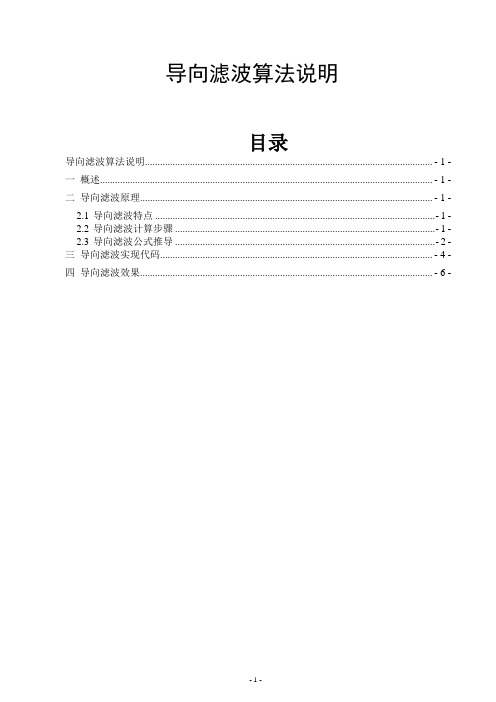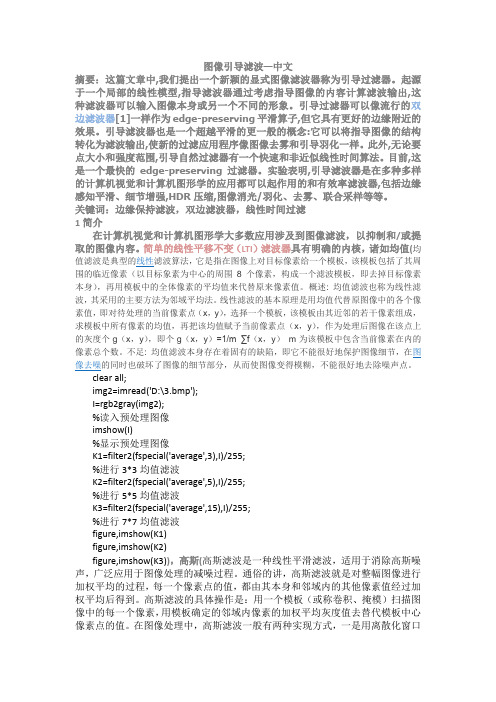图像滤波的引导
导向滤波算法说明(含代码)

导向滤波算法说明目录导向滤波算法说明................................................................................................................... - 1 - 一概述..................................................................................................................................... - 1 - 二导向滤波原理..................................................................................................................... - 1 -2.1导向滤波特点 (1)2.2导向滤波计算步骤 (1)2.3导向滤波公式推导 (2)三导向滤波实现代码............................................................................................................. - 4 - 四导向滤波效果..................................................................................................................... - 6 -导向滤波算法说明一概述本文分为算法原理、Maltab实现代码和算法效果三个部分,对导向滤波算法进行详细说明。
二导向滤波原理2.1导向滤波特点导向滤波有些场合也被称为引导滤波,是何恺明提出的一种保边滤波算法。
gff引导滤波 -回复

gff引导滤波-回复引导滤波(Guided Filter,以下简称GF)是一种图像处理算法,广泛应用在图像增强、图像去噪和图像融合等领域。
它利用了辅助图像的信息,通过对原始图像的像素进行权重调节,实现对图像的滤波处理。
在本文中,将逐步回答GF的原理、应用、优劣势以及实际中的实现方法等问题。
第一部分:原理部分引导滤波的原理是基于卷积操作。
它通过选择与原始图像相关性高的引导图像来实现滤波。
在GF中,引导图像通常是原始图像的某种线性组合。
通过对引导图像和原始图像中每个像素点的局部均值、方差进行加权计算,使得结果图像具有更好的视觉效果。
简而言之,GF是通过对原图像进行加权处理,使得滤波结果更加保留边缘细节和结构信息。
第二部分:应用部分引导滤波在图像增强、图像去噪和图像融合等领域有着广泛的应用。
例如,在图像增强领域,GF可以增强图像的细节和对比度,使得图像更加清晰;在图像去噪方面,GF能够较好地去除图像中的高频噪声,同时保留图像的纹理细节;在图像融合中,GF可以将不同曝光度或焦点的图片进行融合,使得结果图像更加自然。
第三部分:优劣势GF相比于其他滤波算法,具有一些独特的优势和特点。
首先,引导滤波基于对局部均值和方差的加权处理,能够有效地保护图像的细节信息。
其次,GF拥有一个参数epsilon,用来调节平滑强度,可以根据实际需求灵活调整滤波效果。
此外,GF还与图像大小无关,不会引入新的伪影,因此能够较好地处理大尺寸图像。
然而,GF也存在一些劣势。
首先,GF需要引导图像和原始图像之间有较高的相关性,否则滤波效果将较差。
其次,由于GF使用了辅助图像进行滤波,因此在处理大尺寸图像时,算法的计算复杂度较高,会增加运行时间。
此外,GF对边缘信息的保护是通过加权平均实现的,可能导致一些细微的锐化效果损失。
第四部分:实现方法GF的实际实现可以通过以下几个步骤完成:1. 准备原始图像和引导图像,确保两者有较高的相关性。
2. 对原始图像和引导图像进行预处理,如将图像转为灰度图或归一化至0-1之间。
gff引导滤波 -回复

gff引导滤波-回复什么是引导滤波?引导滤波(guided filter)是一种图像增强技术,也是一种非线性滤波器。
它被广泛应用于图像处理中的去噪、图像增强、边缘保留、图像融合等领域。
引导滤波通过使用引导图像来引导滤波器的滤波过程,从而保留图像的边缘信息并提高滤波效果。
引导滤波的原理如下:给定一个输入图像I和一个引导图像P,引导滤波器首先计算P图像的均值和方差,然后通过对I进行线性变换,使得I的均值和方差与P的相匹配,接着使用这个变换后的图像作为引导图像对I进行滤波。
这样做的好处是可以加强I图像中的边缘信息并减少噪声的干扰。
引导滤波具有以下几个步骤:1. 计算引导图像的均值和方差。
引导滤波的第一步是计算引导图像P的平均值和方差。
这可以通过一个滑动窗口的方式实现,窗口的大小可以根据具体的应用场景来确定。
2. 对输入图像进行归一化。
接下来,需要对输入图像I进行归一化处理,使得它的均值和方差与引导图像P相匹配。
这一步的目的是使得I图像的边缘信息与P图像的边缘信息保持一致。
3. 计算I和P的协方差矩阵。
根据归一化处理后的图像I和引导图像P,计算它们的协方差矩阵。
协方差矩阵可以用来度量两个变量之间的相关性,它的计算可以通过计算领域内的I和P的平均值、方差和协方差项来实现。
4. 计算滤波器系数。
通过计算协方差矩阵的逆矩阵和一个称为相关系数的变量,可以得到滤波器的系数。
相关系数决定了滤波器对于I和P的相对权重。
一般情况下,相关系数越大表示引导滤波器越注重保护边缘信息。
5. 进行滤波操作。
根据计算得到的滤波器系数,对归一化后的输入图像I进行滤波处理,得到最终的滤波结果。
引导滤波可以很好地保护图像的边缘信息,并且对于各种类型的图像处理任务都具有良好的适应性。
其在去噪、图像增强、边缘保留、图像融合等领域的应用广泛,成为图像处理中重要的技术手段之一。
通过将引导图像与输入图像进行关联,引导滤波有效地提高了图像滤波的效果,使得结果更加自然细腻。
gff引导滤波 -回复

gff引导滤波-回复什么是gff引导滤波?GFF引导滤波是一种图像处理技术,用于图像去噪和增强。
GFF是指导滤波器(Guided Filter)的简称,它能够通过一个引导图像来帮助滤波器对原始图像进行平滑处理,并保留图像的边缘信息。
GFF引导滤波在计算机视觉和图像处理领域有广泛的应用,例如图像增强、图像去噪、图像修复和边缘检测等。
GFF引导滤波的原理GFF引导滤波的原理基于局部线性模型,它通过在原始图像上添加一个引导图像来进行滤波处理。
引导图像通常是一张灰度图像,它可以是原始图像本身的某个特征提取结果,也可以是另一张相关的图像。
在滤波过程中,滤波器将根据引导图像的信息来调整每个像素的滤波结果,使得处于相似半径窗口内的像素具有相似的滤波效果,从而实现对图像的平滑处理。
GFF引导滤波的步骤1. 读取原始图像和引导图像:首先,需要读取需要进行滤波处理的原始图像和作为引导图像的灰度图像。
引导图像可以是原始图像的某个特征提取结果,也可以是其他相关图像。
2. 计算局部均值和方差:利用一个滑动窗口在原始图像上进行移动,计算每个像素所处窗口内的局部均值和方差。
这一步骤用于计算滤波器的响应模板。
3. 计算滤波系数:根据滤波器的响应模板,计算出每个像素所处窗口内的滤波系数。
滤波系数用于控制滤波器在滤波过程中对每个像素的加权贡献。
4. 执行滤波操作:根据滤波系数,对原始图像进行滤波操作。
滤波操作可以通过卷积等方式来实现,得到最终的滤波结果。
5. 结果输出:将滤波结果输出为一张平滑处理后的图像,该图像在保留原始图像边缘信息的同时去除了图像中的噪声或其他干扰。
GFF引导滤波的优点GFF引导滤波具有以下几个优点:1. 保留边缘信息:通过引导图像的使用,GFF引导滤波能够有效地保留原始图像的边缘信息,避免了传统平滑滤波器可能产生的边缘模糊问题。
2. 提高图像质量:GFF引导滤波能够减少图像中的噪声和其他干扰,从而使得图像更加清晰和可视化。
图像引导滤波—中文

图像引导滤波—中文摘要:这篇文章中,我们提出一个新颖的显式图像滤波器称为引导过滤器。
起源于一个局部的线性模型,指导滤波器通过考虑指导图像的内容计算滤波输出,这种滤波器可以输入图像本身或另一个不同的形象。
引导过滤器可以像流行的双边滤波器[1]一样作为edge-preserving平滑算子,但它具有更好的边缘附近的效果。
引导滤波器也是一个超越平滑的更一般的概念:它可以将指导图像的结构转化为滤波输出,使新的过滤应用程序像图像去雾和引导羽化一样。
此外,无论要点大小和强度范围,引导自然过滤器有一个快速和非近似线性时间算法。
目前,这是一个最快的edge-preserving过滤器。
实验表明,引导滤波器是在多种多样的计算机视觉和计算机图形学的应用都可以起作用的和有效率滤波器,包括边缘感知平滑、细节增强,HDR压缩,图像消光/羽化、去雾、联合采样等等。
关键词:边缘保持滤波,双边滤波器,线性时间过滤1简介在计算机视觉和计算机图形学大多数应用涉及到图像滤波,以抑制和/或提取的图像内容。
简单的线性平移不变(LTI)滤波器具有明确的内核,诸如均值(均值滤波是典型的线性滤波算法,它是指在图像上对目标像素给一个模板,该模板包括了其周围的临近像素(以目标象素为中心的周围8个像素,构成一个滤波模板,即去掉目标像素本身),再用模板中的全体像素的平均值来代替原来像素值。
概述:均值滤波也称为线性滤波,其采用的主要方法为邻域平均法。
线性滤波的基本原理是用均值代替原图像中的各个像素值,即对待处理的当前像素点(x,y),选择一个模板,该模板由其近邻的若干像素组成,求模板中所有像素的均值,再把该均值赋予当前像素点(x,y),作为处理后图像在该点上的灰度个g(x,y),即个g(x,y)=1/m ∑f(x,y)m为该模板中包含当前像素在内的像素总个数。
不足:均值滤波本身存在着固有的缺陷,即它不能很好地保护图像细节,在图像去噪的同时也破坏了图像的细节部分,从而使图像变得模糊,不能很好地去除噪声点。
gff引导滤波 -回复

gff引导滤波-回复什么是引导滤波【gff引导滤波】?引导滤波(Guided Filter)是一种基于图像辅助信息的滤波方法,可以用于图像降噪、去除图像模糊以及图像增强等任务。
与其他滤波方法相比,引导滤波具有较好的保边效果和细节保留能力,能够在保持图像结构和纹理的同时,有效地减少图像噪声。
引导滤波的原理是基于一种称为引导图像的辅助信息。
在引导滤波中,引导图像和待滤波的原始图像是一一对应的。
引导图像通常可以选择原始图像的不同特征图,如亮度图、梯度图或其他感兴趣的特征图。
通过分析引导图像和原始图像之间的关系,引导滤波可以根据引导图像的信息对原始图像进行滤波操作。
引导滤波的一般步骤如下:第一步:计算引导图像。
首先,需要选择一个适当的引导图像,比如亮度图、梯度图或其他特征图。
然后,计算引导图像的均值和方差。
这些统计数据将用于后续的滤波操作。
第二步:计算滤波器的权重。
根据原始图像和引导图像的关系,计算每个像素的滤波权重。
一般而言,滤波权重可以由原始图像和引导图像的相关性来确定。
相关性越大,滤波权重越高。
第三步:应用滤波权重。
利用前两步计算得到的滤波权重,对原始图像进行滤波操作。
具体而言,对于每个像素,根据滤波权重对其周围像素进行加权平均。
这样可以使得滤波操作更加准确和自适应。
第四步:调整图像增强参数。
在引导滤波中,通常还可以通过调整一些参数来进一步改善滤波效果。
比如,可以通过设置滤波窗口的大小来调整滤波的范围,或者通过调整滤波权重的强度来控制滤波的程度。
引导滤波的应用广泛,特别是在图像处理领域。
它不仅可以降低图像噪声,还可以提取图像的细节信息,改善图像的视觉质量。
此外,引导滤波还可以用于图像增强、图像超分辨率重建以及计算机视觉中的其他任务。
总结一下,引导滤波是一种基于图像辅助信息的滤波方法,通过利用引导图像对原始图像进行滤波操作,实现图像降噪、图像增强等目标。
它具有较好的保边效果和细节保留能力,能够在保持图像结构和纹理的同时,有效地减少图像噪声。
导向滤波算法原理

导向滤波算法原理导向滤波算法(Guided Filter)是一种用于图像处理中的滤波技术,它可以在保持图像细节的同时,对图像进行平滑处理。
它在图像去噪、图像增强、图像融合等领域都有广泛的应用。
导向滤波算法的原理基于一个关键的概念:引导图像。
所谓引导图像,即用来指导滤波过程的图像。
在导向滤波算法中,引导图像和待滤波图像具有相同的尺寸,用于定义滤波的引导特征。
通过对引导图像和待滤波图像进行对应的滤波操作,可以得到最终的滤波结果。
具体而言,导向滤波算法的实现过程如下:1. 首先,需要选择一个适当的引导图像。
引导图像应该与待滤波图像有相关性,以确保滤波结果同时考虑了图像的细节和全局信息。
常用的引导图像可以是原始图像的亮度分量、梯度图像等。
2. 然后,计算引导图像的均值和方差。
这可以通过滑动窗口的方式,在引导图像上进行局部均值和方差的计算。
3. 接下来,需要计算待滤波图像在引导图像上的均值。
这个均值的计算同样可以通过滑动窗口的方式,在待滤波图像和引导图像上同时进行。
4. 然后,计算待滤波图像在引导图像上的协方差。
这个协方差的计算同样可以通过滑动窗口的方式,在待滤波图像和引导图像上同时进行。
5. 最后,根据计算得到的均值和协方差,可以得到最终的滤波结果。
具体的滤波操作可以基于线性滤波、非线性滤波等方法进行。
导向滤波算法的核心思想是通过引导图像来指导滤波过程,从而在平滑图像的同时保留图像的细节信息。
相比传统的滤波算法,导向滤波算法在边缘保持和细节增强方面具有更好的效果。
它能够有效地去除图像中的噪声,同时保持图像的纹理和边缘信息,使得图像更加清晰、自然。
导向滤波算法在图像处理领域有着广泛的应用。
例如,在图像去噪中,导向滤波算法可以在去除噪声的同时,保持图像的细节和纹理;在图像增强中,导向滤波算法可以增强图像的边缘和纹理,使得图像更加鲜明;在图像融合中,导向滤波算法可以将多幅图像融合为一幅清晰、自然的图像。
导向滤波算法是一种有效的图像滤波技术,能够在保持图像细节的同时,对图像进行平滑处理。
gff引导滤波 -回复

gff引导滤波-回复引导滤波(guided filter)是一种图像处理的滤波方法,“gff”是其英文名称“guided filter”的缩写。
本文将详细介绍引导滤波的原理、应用场景以及具体实现步骤。
一、引导滤波的原理引导滤波是一种基于局部线性模型的滤波方法,相比于传统的滤波方法,它能够在对图像进行平滑的同时,保持边缘信息。
引导滤波主要通过引导图像来指导滤波过程。
具体来说,引导滤波通过对输入图像和引导图像之间的关系进行建模,得到一个权重矩阵,然后利用该权重矩阵对输入图像进行滤波。
这个权重矩阵体现了输入图像中的每个像素对引导图像的依赖程度,从而在平滑图像的同时保留了边缘信息。
二、引导滤波的应用场景引导滤波在图像处理领域有着广泛的应用场景,包括但不限于以下几个方面:1. 图像去噪:引导滤波可以去除图像中的噪声,同时保持图像的细节。
由于其能够较好地保留图像中的边缘信息,在一些对边缘敏感的图像处理任务中表现出色。
2. 图像增强:引导滤波可以增强图像的对比度和细节,并减少图像中的噪声。
它能够通过引导图像来保留图像中的纹理细节,并改善暗部细节。
3. 双边滤波:引导滤波是双边滤波的一种变体,可以在平滑图像的同时保留图像中的边缘信息。
双边滤波在计算机视觉中常用于图像的平滑处理,也可以用于图像分割和边缘检测等任务。
三、引导滤波的具体实现步骤引导滤波的实现主要包括以下几个步骤:1. 输入图像和引导图像:首先,需要准备一张需要进行滤波处理的输入图像,同时还需要一张引导图像,用来指导滤波过程。
2. 确定滤波窗口:对于输入图像中的每个像素,需要确定一个局部窗口,在这个窗口内进行滤波操作。
通常情况下,窗口大小会根据具体的应用需求进行设置。
3. 计算局部均值和方差:在每个窗口内,需要计算输入图像和引导图像的局部均值和方差。
这些统计量将用于估计滤波窗口内的线性模型。
4. 计算滤波权重:根据局部均值、方差以及输入图像和引导图像之间的协方差,可以计算出滤波窗口内的每个像素的权重。
- 1、下载文档前请自行甄别文档内容的完整性,平台不提供额外的编辑、内容补充、找答案等附加服务。
- 2、"仅部分预览"的文档,不可在线预览部分如存在完整性等问题,可反馈申请退款(可完整预览的文档不适用该条件!)。
- 3、如文档侵犯您的权益,请联系客服反馈,我们会尽快为您处理(人工客服工作时间:9:00-18:30)。
2
2.1
Related Work
Bilateral Filter
The bilateral filter computes the filter output at a pixel as a weighted average of neighboring pixels. It smoothes the image while preserving edges. Due to this nice property, it has been widely used in noise reduction [18], HDR compression [12], multi-scale detail decomposition [19], and image abstraction [20]. It is generalized to the joint bilateral filter in [11], in which the weights are computed from another guidance image rather than the filter input. The joint bilateral filter is particular favored when the filter input is not reliable to provide edge information, e.g., when it is very noisy or is an intermediate result. The joint bilateral filter is applicable in flash/no-flash denoising [11], image upsamling [21], and image deconvolution [22]. However, it has been noticed [12, 13, 8] that the bilateral filter may have the gradient reversal artifacts in detail decomposition and HDR compression. The reason is that when a pixel (often on an edge) has few similar pixels around it, the Gaussian weighted average is unstable. Another issue concerning the bilateral filter is its efficiency. The brute-force implementation isct. In this paper, we propose a novel type of explicit image filter - guided filter. Derived from a local linear model, the guided filter generates the filtering output by considering the content of a guidance image, which can be the input image itself or another different image. The guided filter can perform as an edge-preserving smoothing operator like the popular bilateral filter [1], but has better behavior near the edges. It also has a theoretical connection with the matting Laplacian matrix [2], so is a more generic concept than a smoothing operator and can better utilize the structures in the guidance image. Moreover, the guided filter has a fast and non-approximate linear-time algorithm, whose computational complexity is independent of the filtering kernel size. We demonstrate that the guided filter is both effective and efficient in a great variety of computer vision and computer graphics applications including noise reduction, detail smoothing/enhancement, HDR compression, image matting/feathering, haze removal, and joint upsampling.
Guided Image Filtering
Kaiming He1 , Jian Sun2 , and Xiaoou Tang1,3
1 3
Department of Information Engineering, The Chinese University of Hong Kong 2 Microsoft Research Asia Shenzhen Institutes of Advanced Technology, Chinese Academy of Sciences, China
2
applications, like colorization [7], image matting [2], multi-scale decomposition [8], and haze removal [9]. While this optimization-based approach often yields the state-of-the-art quality, it comes with the price of long computational time. The other approach is to explicitly build the filter kernels using the guidance image. The bilateral filter, proposed in [10], made popular in [1], and later generalized in [11], is perhaps the most popular one of such filters. Its output at a pixel is a weighted average of the nearby pixels, where the weights depend on the intensity/color similarities in the guidance image. The guidance image can be the filter input itself [1] or another image [11]. The bilateral filter can smooth small fluctuations and preserve edges. While this filter is effective in many situations, it may have unwanted gradient reversal artifacts [12, 13, 8] near edges (further explained in Section 3.4). Its fast implementation is also a challenging problem. Recent techniques [14–17] rely on quantization methods to accelerate but may sacrifice the accuracy. In this paper we propose a new type of explicit image filter, called guided filter. The filtering output is locally a linear transform of the guidance image. This filter has the edge-preserving smoothing property like the bilateral filter, but does not suffer from the gradient reversal artifacts. It is also related to the matting Laplacian matrix [2], so is a more generic concept and is applicable in other applications beyond the scope of ”smoothing”. Moreover, the guided filter has an O(N) time (in the number of pixels N) exact algorithm for both gray-scale and color images. Experiments show that the guided filter performs very well in terms of both quality and efficiency in a great variety of applications, such as noise reduction, detail smoothing/enhancement, HDR compression, image matting/feathering, haze removal, and joint upsampling.
